 Facebook
Facebook
 X
X
 Instagram
Instagram
 TikTok
TikTok
 Youtube
Youtube
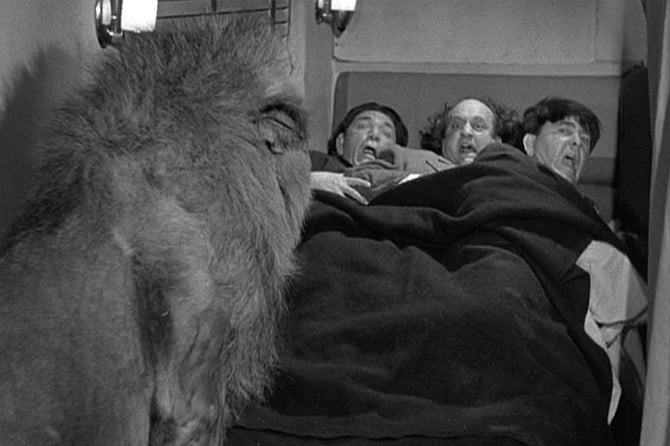
Hold That Lion is legendary among Stooge disciples as the only time Shemp and Curly appear on screen together. It is also Curly’s swan song.
Hold That Lion (1947)
By this time, doctor’s orders had called for Curly to relinquish the coveted third Stooge spot to brother Shemp. (He appears as “Man Sleeping on Train.”) It was a challenging period all around, what with the onslaught of television causing the Columbia shorts unit to economise. Originality was supplanted by the cost cutting need to repurpose past efforts. Long before America went green, filmmaker Jules White was one of the earliest practitioners of recycling — the studio would not let go of Hold That Lion. Between March and May of 1953, eight years before Ingmar Bergman kicked off his “Death of God” trilogy with Through a Glass Darkly, Columbia Pictures released three “new” Stooge shorts to first run theatres that would collectively come to be known as the “Death of Shemp” trilogy. Hold That Lion adds water to the triad soup, all directed by Mr. White. Combine the bits and pieces, and these shorts contain the entire 1947 two-reeler.

Hold That Lion features bit player Kenneth MacDonald in the career-defining role of Ichabod Slipp, a character he would revive two years later for another pair of shorts. After he swindles the boys, our trio of process-serving knuckleheads trail him to Union Station and hop a train, aiming to slap Slipp with a “subpeeny.” But Slipp isn’t the only threat on board: an escaped lion wreaks havoc among the day-players. (The sparkling video restoration reveals a new-found flaw heretofore indiscernible in softer TV prints. Look carefully when the boys are trapped in the cage with Leo. One can now spot the camera reflection in the pane of glass that separates Stooges from their maned menace.) Also take note of the terrorizing FAO Schwarz stuffed lion at the foot of their bunk. (Three can sleep cheaper than one.)

Doubles, dubs, and a cringe-worthy Dudley Dickerson round out the festivities. Gasp as the mangy-haired Larry stunt double flees the lion’s cage. Listen to the passengers’ blase, dubbed in moans of, “Oh, a lion,” and, “Look, a lion.” And what can be said of Stooge-regular Dickerson? Columbia Pictures head Harry Cohn vowed that the only time a person of color would appear in one of his films was if they were cast in a subservient role. As the hapless train porter, Dickerson is Cohn’s theory put to the test.
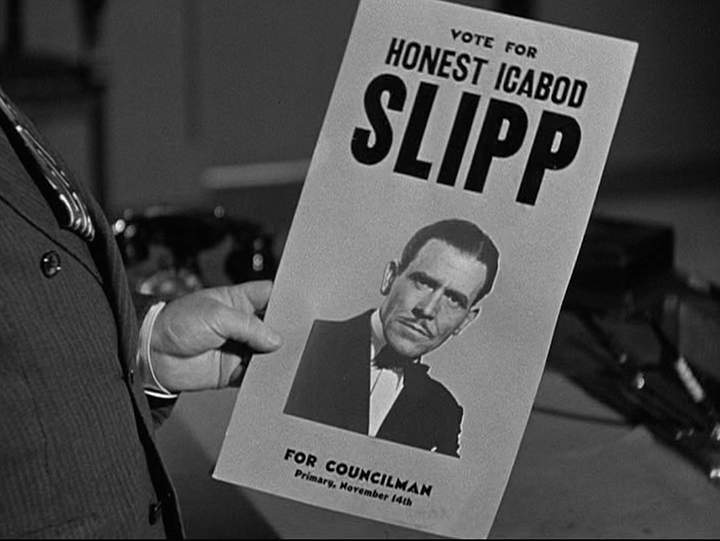
Watch Loose Loot before Booty and the Beast to find a stronger appreciation of Hold That Lion’s proper chronology. Tricky Dicks, the least of the bunch to reprocess past glories, contains but one brief reused segment. I’m sure you will all agree that my reasons for including it solely on the basis of Murray Alper’s performance are justified.
Booty and the Beast (1953)
Booty and the Beast joins Godfather II and Gremlins 2 as one of those rare sequels that outshines its predecessor. The short opens on new footage of old Kenneth MacDonald playing a burglar breaking and entering into a cheap soundstage flat. After he bamboozles the boys into believing he’s the owner of the house, they willingly aid and abet the desperate intruder’s attempt to gain entry, and an inevitable safe cracking subplot ensues. The mighty Stooges pull up in front of a rolled painted backdrop of a poverty row Twelve Oaks. The reason it looks so unconvincing is because it’s a flat backdrop, not a trans-screen (a translucent picture lit from behind).
Moe is at his most abusive while under Jules White’s watch. In one of the team’s most brutal exercises, Moe chokes, groin stomps, kicks, hammers, dislodges teeth, and spits in Shemp’s eye before threatening to use a stick of TNT to push it through the other side of its socket. Commanding Larry to bend over, Moe sets the willing Stooge up for a mud facial. A dual-function power drill burrows Shemp a second rectus before playing joy buzzer to Moe’s palm. (Larry enthusiasts will delight when the venerated middle Stooge comes to Shemp’s defense with his trademark cry of, “Hey, leave him alone.”) The scene reaches its dizzying crescendo when Moe, the perpetually pissed off Uber Stooge, points the power tool at Larry’s forehead and bitterly snarls, “I’ll jam it in your face.”
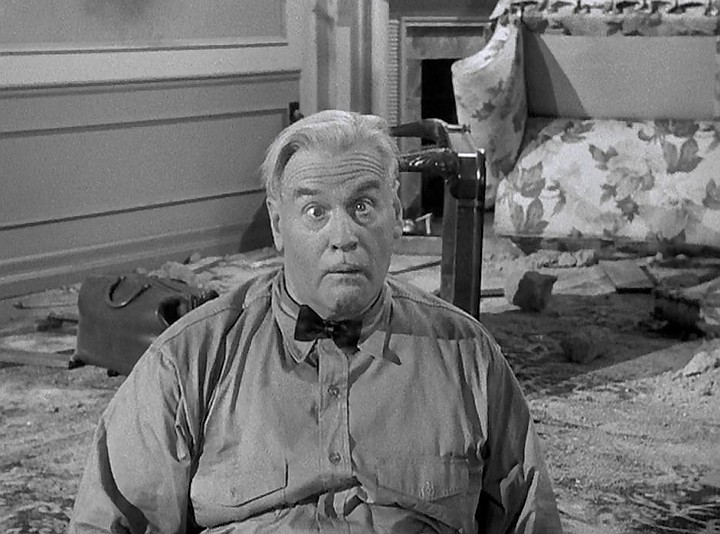
Aside from our trio of halfwits, MacDonald’s revival of infamous Ichabod Slipp is, in one form or another, the film’s unifying link. The Nixonian MacDonald plays a man with no name, thus enabling Columbia’s crack sound editors to seamlessly (and seemingly) transform I. Slipp into a new and fascinating screen presence. MacDonald looks like a deer caught in the grip truck’s headlights as he fumbles with a crowbar to jimmy his way through the balsa wood plantation. The surrogate Slipp absconds with the loot, leaving ample running time for a sagging Vernon Dent to show up for SAG scale. Dressed in a costume more befitting a filling station attendant than a security guard, the white-haired, belt-busting bit player looks every day of his 58 years — plus 30. Kudos to the corpulent comic trooper for performing his own stunt. The production probably couldn’t afford to pop for a dummy that big.
At precisely 7:38, an optical wipe transports us six years into the past when such luxuries as extras, props and set dressing were built into the budget. What makes this reimagining unique can be found in the extensive effort needed to maintain continuity by redubbing every utterance of Slipp’s name. Whole sentences are replaced, but it’s a quick one word substitution that functions as the short’s raison d’être. A dazed Moe looks up, takes one look at stock footage Slipp and cries, “Hey, its’ him.” We conclude with the five seconds of fresh footage necessary to tie up the new plot line.
Loose Loot (1953)
Working in achronological order, Columbia’s crack creative team chose to use the tail of the Lion to round out Booty and the Lion’s head to begin Loose Loot. The same custom-lettered “Cess, Poole & Drayne” door signage that opens Hold that Lion ignites Loose Loot. For the first time, MacDonald officially reprises the role of I. Slipp. Slipp2 slips into character at precisely 1.52. In a fleet 30 seconds, the filmmakers establish that once the next patch of stock footage wraps, the remainder of the short will play out at the Circle Follies Theatre. (In a nod to the Stooges’ Hebraic ancestry, the offices of Honest Ichabod’s Theatrical Enterprises and Real Estate offices are located in the Knish Building.) With the exception of an insert shot of a placard displaying a youthful, dapper MacDonald that brings the Stooges up to speed, the first 6 minutes and 35 seconds of the short is lifted directly from Hold That Lion.
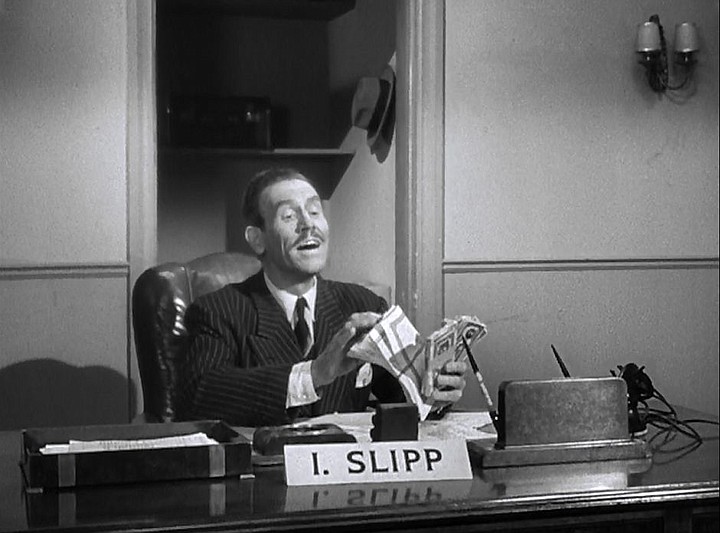
An older looking trio continues the new plot thread. A leggy starlet leads the lecherous knuckleheads face to face with Slipp2. Taking a giant step down from his salad days with W.C. Fields and The Marx Bros., beefy character actor Tom Kennedy (not the brother of Jack Narz) plays Slipp2’s enforcer. Alas, the umpteenth variation of the hallway chase featuring the Stooges and their pursuers zig-zagging in and out of assorted cardboard door frames lacked the undercranking necessary to hold the attention of this reviewer.
Displaying a Bizarro World appreciation of Hitchcock, director White uses his camera to show the viewer what it would be like being trapped in a straw-filled packing crate with these men. And for the first time, Stooge women are brought to the trilogy for the sole purpose of being brutalized. French showgirl Nannette Bordeaux and the man-eating Suzanne Ridgeway get their noggins knocked together by a clumsy Shemp. And in an S&M rage, Shemp, inexplicably clad in cowboy boots complete with spurs, slaps the thigh of the Parisian strumpet with a sword.
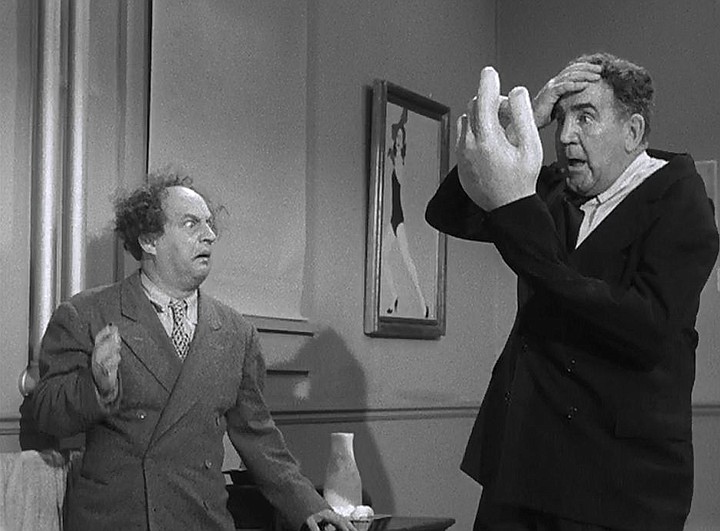
Apart from the posed placard shot, MacDonald’s most memorable moment in this entry comes when he pokes his head through a hole in the door to take a bite out of Moe’s ashtray-sized ear. The aforementioned hole acts as a catalyst for the opportunity to introduce additional slapstick torture. The boys use a chair to ensnare Slipp2’s head and proceed to pelt him with rotten fruit, beer bottles, and eggs — all underscored by MacDonald’s dubbed in moans. The White touch is most effectively felt in a brief, ineptly staged flurry of swordplay between Shemp and Slipp2. Rapidly approaching the studio mandated running time of 16 minutes, Shemp introduces his sword to Slipp’s backside, thus grinding the proceedings to a halt. The curtain gag — a real life actor posing as a framed portrait of Napoleon — that delighted me as a child failed to have the same effect when viewed with a more critical discipline.
Tricky Dicks (1947)
Eager to recycle every frame of Hold That Lion, the studio tacked the remaining file cabinet sequence onto the last film in the cycle, Tricky Dicks. Sadly, it’s the one short in the bunch that doesn’t feature MacDonald. (Not unlike Robert Duvall in The Godfather: Part II, the studio refused to meet MacDonald’s salary demands.) The trio star as policemen under the annoyingly watchful supervision of Chief Detective B.A. Copper (Ferris Taylor). The short houses dreary cameos by Connie Cezan as a kleptomaniac, Benny Rubin as a British gypsy, and milquetoast Phil Arnold as a misunderstood murderer. There is even an insufferable stretch involving Shemp and a monkey. The otherwise unwatchable short explodes with a protracted scene of excessive gunplay that anticipates Sam Peckinpah and John Woo by decades. Could it be possible that Scorsese saw this at an impressionable age and called it to memory while designing the extended slaughter that concludes Taxi Driver?
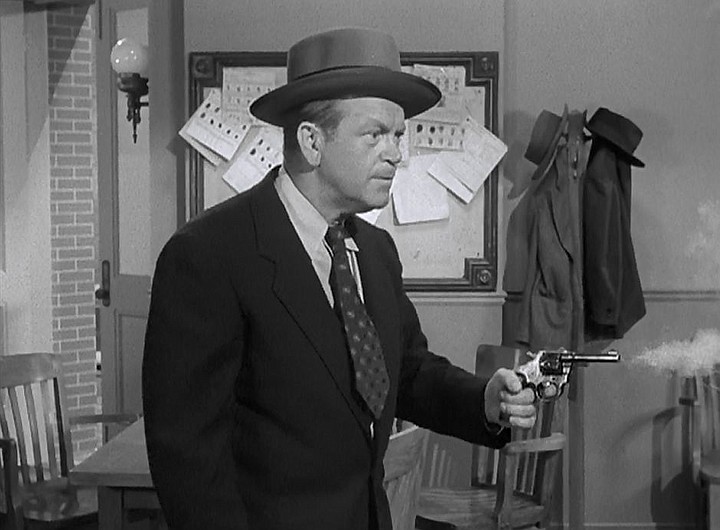
Murray Alper plays a self-described “thrill killer” whose six shooter holds more bullets than Albert Finney’s tommy gun in Miller’s Crossing. One would need the accounting firm of Price Waterhouse to count the number of bullets that fly from his gun. (I tried.) There are more gunshot sound effects used in this short than in Columbia’s megahit The Guns of Navarone. Aiming at everything and nothing, the character’s explosive outburst overwhelms the viewer with its wanton display of post-Korean war existential angst. Positioning Alper motionless in mid-frame, the red hot White unleashes a personal/political statement: Alper’s brutality is a direct externalization of Whites’ deep-seated hostility toward studio heads who trimmed his already modest budgets.
White goes so far as to sacrifice the Christ figure in his passion play by killing Shemp! No kidding! The oscillating Alper pumps at least a dozen bullets into Shemp’s chest at point blank range. (This guy could have brought down the bus in The Gauntlet.) In the end, it is not Stooge ingenuity that saves the day, but the obligatory placement of bowling balls atop a wobbly cabinet or shelf just waiting to be bumped into.
Booty and the Beast hit theatre screens March 5, 1953, followed on April 2, 1953 by Loose Loot and the release of Tricky Dicks on May 7, 1953. In essence, a theatergoer saw the same short over a three month period with no let up. The parents didn’t mind, but I’m betting the more observant youngsters in attendance took notice!


Hold That Lion is legendary among Stooge disciples as the only time Shemp and Curly appear on screen together. It is also Curly’s swan song.
Hold That Lion (1947)
By this time, doctor’s orders had called for Curly to relinquish the coveted third Stooge spot to brother Shemp. (He appears as “Man Sleeping on Train.”) It was a challenging period all around, what with the onslaught of television causing the Columbia shorts unit to economise. Originality was supplanted by the cost cutting need to repurpose past efforts. Long before America went green, filmmaker Jules White was one of the earliest practitioners of recycling — the studio would not let go of Hold That Lion. Between March and May of 1953, eight years before Ingmar Bergman kicked off his “Death of God” trilogy with Through a Glass Darkly, Columbia Pictures released three “new” Stooge shorts to first run theatres that would collectively come to be known as the “Death of Shemp” trilogy. Hold That Lion adds water to the triad soup, all directed by Mr. White. Combine the bits and pieces, and these shorts contain the entire 1947 two-reeler.

Hold That Lion features bit player Kenneth MacDonald in the career-defining role of Ichabod Slipp, a character he would revive two years later for another pair of shorts. After he swindles the boys, our trio of process-serving knuckleheads trail him to Union Station and hop a train, aiming to slap Slipp with a “subpeeny.” But Slipp isn’t the only threat on board: an escaped lion wreaks havoc among the day-players. (The sparkling video restoration reveals a new-found flaw heretofore indiscernible in softer TV prints. Look carefully when the boys are trapped in the cage with Leo. One can now spot the camera reflection in the pane of glass that separates Stooges from their maned menace.) Also take note of the terrorizing FAO Schwarz stuffed lion at the foot of their bunk. (Three can sleep cheaper than one.)

Doubles, dubs, and a cringe-worthy Dudley Dickerson round out the festivities. Gasp as the mangy-haired Larry stunt double flees the lion’s cage. Listen to the passengers’ blase, dubbed in moans of, “Oh, a lion,” and, “Look, a lion.” And what can be said of Stooge-regular Dickerson? Columbia Pictures head Harry Cohn vowed that the only time a person of color would appear in one of his films was if they were cast in a subservient role. As the hapless train porter, Dickerson is Cohn’s theory put to the test.

Watch Loose Loot before Booty and the Beast to find a stronger appreciation of Hold That Lion’s proper chronology. Tricky Dicks, the least of the bunch to reprocess past glories, contains but one brief reused segment. I’m sure you will all agree that my reasons for including it solely on the basis of Murray Alper’s performance are justified.
Booty and the Beast (1953)
Booty and the Beast joins Godfather II and Gremlins 2 as one of those rare sequels that outshines its predecessor. The short opens on new footage of old Kenneth MacDonald playing a burglar breaking and entering into a cheap soundstage flat. After he bamboozles the boys into believing he’s the owner of the house, they willingly aid and abet the desperate intruder’s attempt to gain entry, and an inevitable safe cracking subplot ensues. The mighty Stooges pull up in front of a rolled painted backdrop of a poverty row Twelve Oaks. The reason it looks so unconvincing is because it’s a flat backdrop, not a trans-screen (a translucent picture lit from behind).
Moe is at his most abusive while under Jules White’s watch. In one of the team’s most brutal exercises, Moe chokes, groin stomps, kicks, hammers, dislodges teeth, and spits in Shemp’s eye before threatening to use a stick of TNT to push it through the other side of its socket. Commanding Larry to bend over, Moe sets the willing Stooge up for a mud facial. A dual-function power drill burrows Shemp a second rectus before playing joy buzzer to Moe’s palm. (Larry enthusiasts will delight when the venerated middle Stooge comes to Shemp’s defense with his trademark cry of, “Hey, leave him alone.”) The scene reaches its dizzying crescendo when Moe, the perpetually pissed off Uber Stooge, points the power tool at Larry’s forehead and bitterly snarls, “I’ll jam it in your face.”

Aside from our trio of halfwits, MacDonald’s revival of infamous Ichabod Slipp is, in one form or another, the film’s unifying link. The Nixonian MacDonald plays a man with no name, thus enabling Columbia’s crack sound editors to seamlessly (and seemingly) transform I. Slipp into a new and fascinating screen presence. MacDonald looks like a deer caught in the grip truck’s headlights as he fumbles with a crowbar to jimmy his way through the balsa wood plantation. The surrogate Slipp absconds with the loot, leaving ample running time for a sagging Vernon Dent to show up for SAG scale. Dressed in a costume more befitting a filling station attendant than a security guard, the white-haired, belt-busting bit player looks every day of his 58 years — plus 30. Kudos to the corpulent comic trooper for performing his own stunt. The production probably couldn’t afford to pop for a dummy that big.
At precisely 7:38, an optical wipe transports us six years into the past when such luxuries as extras, props and set dressing were built into the budget. What makes this reimagining unique can be found in the extensive effort needed to maintain continuity by redubbing every utterance of Slipp’s name. Whole sentences are replaced, but it’s a quick one word substitution that functions as the short’s raison d’être. A dazed Moe looks up, takes one look at stock footage Slipp and cries, “Hey, its’ him.” We conclude with the five seconds of fresh footage necessary to tie up the new plot line.
Loose Loot (1953)
Working in achronological order, Columbia’s crack creative team chose to use the tail of the Lion to round out Booty and the Lion’s head to begin Loose Loot. The same custom-lettered “Cess, Poole & Drayne” door signage that opens Hold that Lion ignites Loose Loot. For the first time, MacDonald officially reprises the role of I. Slipp. Slipp2 slips into character at precisely 1.52. In a fleet 30 seconds, the filmmakers establish that once the next patch of stock footage wraps, the remainder of the short will play out at the Circle Follies Theatre. (In a nod to the Stooges’ Hebraic ancestry, the offices of Honest Ichabod’s Theatrical Enterprises and Real Estate offices are located in the Knish Building.) With the exception of an insert shot of a placard displaying a youthful, dapper MacDonald that brings the Stooges up to speed, the first 6 minutes and 35 seconds of the short is lifted directly from Hold That Lion.

An older looking trio continues the new plot thread. A leggy starlet leads the lecherous knuckleheads face to face with Slipp2. Taking a giant step down from his salad days with W.C. Fields and The Marx Bros., beefy character actor Tom Kennedy (not the brother of Jack Narz) plays Slipp2’s enforcer. Alas, the umpteenth variation of the hallway chase featuring the Stooges and their pursuers zig-zagging in and out of assorted cardboard door frames lacked the undercranking necessary to hold the attention of this reviewer.
Displaying a Bizarro World appreciation of Hitchcock, director White uses his camera to show the viewer what it would be like being trapped in a straw-filled packing crate with these men. And for the first time, Stooge women are brought to the trilogy for the sole purpose of being brutalized. French showgirl Nannette Bordeaux and the man-eating Suzanne Ridgeway get their noggins knocked together by a clumsy Shemp. And in an S&M rage, Shemp, inexplicably clad in cowboy boots complete with spurs, slaps the thigh of the Parisian strumpet with a sword.

Apart from the posed placard shot, MacDonald’s most memorable moment in this entry comes when he pokes his head through a hole in the door to take a bite out of Moe’s ashtray-sized ear. The aforementioned hole acts as a catalyst for the opportunity to introduce additional slapstick torture. The boys use a chair to ensnare Slipp2’s head and proceed to pelt him with rotten fruit, beer bottles, and eggs — all underscored by MacDonald’s dubbed in moans. The White touch is most effectively felt in a brief, ineptly staged flurry of swordplay between Shemp and Slipp2. Rapidly approaching the studio mandated running time of 16 minutes, Shemp introduces his sword to Slipp’s backside, thus grinding the proceedings to a halt. The curtain gag — a real life actor posing as a framed portrait of Napoleon — that delighted me as a child failed to have the same effect when viewed with a more critical discipline.
Tricky Dicks (1947)
Eager to recycle every frame of Hold That Lion, the studio tacked the remaining file cabinet sequence onto the last film in the cycle, Tricky Dicks. Sadly, it’s the one short in the bunch that doesn’t feature MacDonald. (Not unlike Robert Duvall in The Godfather: Part II, the studio refused to meet MacDonald’s salary demands.) The trio star as policemen under the annoyingly watchful supervision of Chief Detective B.A. Copper (Ferris Taylor). The short houses dreary cameos by Connie Cezan as a kleptomaniac, Benny Rubin as a British gypsy, and milquetoast Phil Arnold as a misunderstood murderer. There is even an insufferable stretch involving Shemp and a monkey. The otherwise unwatchable short explodes with a protracted scene of excessive gunplay that anticipates Sam Peckinpah and John Woo by decades. Could it be possible that Scorsese saw this at an impressionable age and called it to memory while designing the extended slaughter that concludes Taxi Driver?

Murray Alper plays a self-described “thrill killer” whose six shooter holds more bullets than Albert Finney’s tommy gun in Miller’s Crossing. One would need the accounting firm of Price Waterhouse to count the number of bullets that fly from his gun. (I tried.) There are more gunshot sound effects used in this short than in Columbia’s megahit The Guns of Navarone. Aiming at everything and nothing, the character’s explosive outburst overwhelms the viewer with its wanton display of post-Korean war existential angst. Positioning Alper motionless in mid-frame, the red hot White unleashes a personal/political statement: Alper’s brutality is a direct externalization of Whites’ deep-seated hostility toward studio heads who trimmed his already modest budgets.
White goes so far as to sacrifice the Christ figure in his passion play by killing Shemp! No kidding! The oscillating Alper pumps at least a dozen bullets into Shemp’s chest at point blank range. (This guy could have brought down the bus in The Gauntlet.) In the end, it is not Stooge ingenuity that saves the day, but the obligatory placement of bowling balls atop a wobbly cabinet or shelf just waiting to be bumped into.
Booty and the Beast hit theatre screens March 5, 1953, followed on April 2, 1953 by Loose Loot and the release of Tricky Dicks on May 7, 1953. In essence, a theatergoer saw the same short over a three month period with no let up. The parents didn’t mind, but I’m betting the more observant youngsters in attendance took notice!
Comments